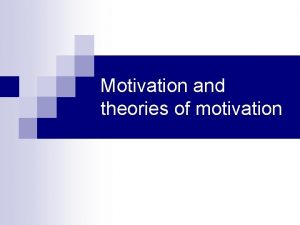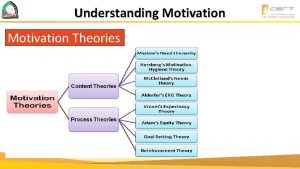Motivation Theories Theory X and Theory Y are





- Slides: 5

Motivation Theories • Theory X and Theory Y are theories of motivation given by Douglas Mc. Gregor in 1960’s. These theories are based on the premise that management has to assemble all the factors of production, including human beings, to get the work done.


Theory X: Theory X relies on the authoritarian style of management, where the managers are required to give instructions and keep a close check on each employee. As it is assumed, the employees are not motivated, and they dislike working. This theory is based on the following assumptions: • The employee is lazy and dislikes work. • He is not ambitious and dislikes responsibility. • The employee is self-centered and indifferent towards the organizational interest. • Management is responsible for assembling all the factors of production, Money, material, equipment, people. • The managers are required to control his employees, manage their efforts, motivate them, and modify their behavior to comply with the organizational needs.

• Theory Y: Theory Y relies on the participative style of management, where the managers assume that the employees are self-directed and self- motivated to accomplish the organizational objectives. Thus, here the management attempts to get the maximum output with least efforts on their part.

• Following are the assumptions of Theory Y: • The average human being does not inherently dislike work, they are creative and self-motivated and likes to work with greater responsibilities. • Employees are self-directed and self-controlled and therefore threat of punishment is not only the means for getting the desired results. • The extent to which an employee is committed to objectives is determined by the rewards associated with their achievement. The most significant rewards in this context could be the satisfaction of the ego and the fulfillment of self-actualization needs. • The average human being is ambitious and is ready to take responsibilities. He likes to lead rather than to be led by others. • The employees exercise a relatively high degree of imagination and creativity in solving the complex organizational problems. • Thus, theory X and theory Y are two contrasting models that depict the set of assumptions a manager holds on his employees, which may or may not coincide with their general way of behaving. Therefore, these theories are based on the attitude, not attributes.









